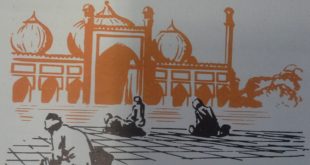Thirteen and a half centuries ago a new religion began in Arabia. Today millions of people are followers of this religion. It is called Islam and its followers, Moslems. All their lives long, Moslems must pray, in ways clearly prescribed, five times every day. No ordinary event must be allowed to interfere with these moments of prayer. Moslems must learn to recite their creed — a long statement of their religious belief. For one month each year they must fast all of every day from sunrise to sunset. They must give generously to charity. They should, if at all possible, go at least once during their lives to the holy city of Mecca, where Mohammed, the founder of Islam, began this new religion. People of other faiths are forbidden to enter Mecca. A few miles outside of Mecca, Moslems must change to pilgrims’ dress and proceed barefoot when they enter this city, high up in west-central Arabia. Mohammed and his first followers were Arabs. Arab merchants and Arab warriors, influenced the history of other peoples. United by loyalty to their religious faith, Arabs created a large empire. Arab rulers occupied positions of great influence and were keenly interested in advancing learning. How did all this come about? 1. How did the religion of Mohammed create a powerful Moslem world? 2. What kind of civilization developed in the Moslem world? 1. How did the Religion of Mohammed Create a Powerful Moslem World? Arab civilization started later than other great civilizations. The story of the Moslem world began about 600 A.D. in Arabia, a huge peninsula covered for the most part with burning desert. Arabia is separated from Africa by the Red Sea and from Iran (Persia) by the Persian Gulf. To the north and west of the Arabian peninsula is the …
Read More »The Crusades 1096-1260
ON A COLD NOVEMBER DAY IN 1096, a great crowd of people gathered in a field at the town of Clermont in France. They had come from miles around and near them were pitched the tents they had put up for shelter. For some days, Pope Urban II had been holding a great council of cardinals, bishops and princes. Today he was to speak to the people and so many wanted to hear that no building was large enough to hold them all. A platform had been built in the center of the field and as Pope Urban stepped up on it a hush fell over the crowd. Pope Urban was a Frenchman and he spoke to the people around him as fellow Frenchmen. “Oh, race of Franks,” he said, “race beloved and chosen by God . . . set apart from all other nations by the situation of your country as well as by your Catholic faith and the honour which you render to the holy Church: to you our discourse is addressed. . . .” “From the confines of Jerusalem and from Constantinople a grievous report has gone forth that an accursed race, wholly alienated from God, has violently invaded the lands of these Christians and has depopulated them by pillage and fire. They have led away a part of the captives into their own country and a part they have killed by cruel tortures. . .” The people knew what he meant. He was speaking of the Holy Land, that lay on the eastern shores of the Mediterranean Sea. Here were the cities of Jerusalem, Nazareth, Gaza and Damascus. Here Jesus Christ had lived and preached and had been crucified; here Christianity had begun. Here were many sacred shrines and during the Middle Ages thousands of Europeans …
Read More »Seljuks and Mamelukes A.D. 950-1517
LIKE THEIR relatives the Mongols, the Turks began as wandering herdsmen in Central Asia. Their first contact with Islam was as victims rather than victors. When Arab armies overran the southern part of their homeland in the eighth century, many Turks were captured and enslaved. Recognizing their talent for fighting, their new masters enrolled them in their armies. In time, many of them reached high positions in the lands of their adopted religion. About the middle of the tenth century, tribesmen from Turkistan, led by a chief named Seljuk, settled near the city of Bokhara. There they became converted to the Sunnite creed of Islam. From Bokhara, Seljuk set out on a career of conquest. His sons carried on, fighting their way slowly across Western Asia. At last, in 1055, Seljuk’s grandson Tughril took Baghdad. Tughril left the city in charge of his officers and went away. When he came back the next year, the Abbasid capital greeted him with elaborate ceremony. The caliph, wearing Mohammed’s own cloak and carrying his cane, named Tughril “King of the East and of the West.” Officially, Tughril became al-sultan, “he with authority.” From then on, Turkish sultans of the Seljuk family were to control the caliphate for a century and a half, using the Abbasid caliphs as pawns. THE SELJUK TURKS As Turkish tribesmen rushed to enlist in their armies, the Seljuks pushed their conquests outward in all directions. Soon western Asia was again united — as in the days of al-Mansur, Harun and al Mamun — in a mighty Moslem kingdom. Tughril’s successor, Alp Arslan, whose odd-sounding name meant “hero-lion” in Turkish, seized the capital of Christian Armenia. In 1071 he defeated the main army of the Byzantines, taking the emperor captive. Heading west, Seljuk soldiers penetrated the valleys of Asia Minor. …
Read More »


